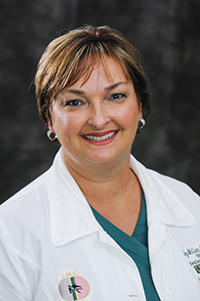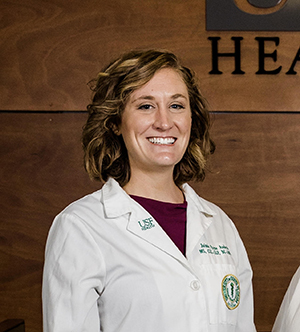Internal Medicine
Joy McCann Culverhouse Center for Swallowing Disorders
At USF Health we offer a comprehensive, multidisciplinary approach to the diagnosis and treatment of swallowing disorders. Our healthcare experts are dedicated to providing the most accurate diagnosis, medical advice, and treatment for swallowing problems.
Our staff includes:
- Board certified gastroenterologists who specialize in disorders of swallowing and esophageal diseases (esophagology)
- Board certified speech language pathologists who specialize in evaluation and treatment of oropharyngeal swallowing disorders
- Esophageal surgeons which specialize in swallowing disorders and surgical management of esophageal disorders.
- Specialty nurses who preform high resolution manometry and ambulatory reflux testing.
The Joy McCann Culverhouse Center for Swallowing Disorders is the one of the only endowed Swallowing Centers in the UnitedStates and treats the largest number of eosinophilic esophagitis patients in Florida.
Conditions We Treat
- Achalasia
- Aerophagia, supragastric belching, and gastric belching
- Barrett’s esophagus
- Complex esophageal strictures
- Eosinophilic esophagitis
- Esophageal cancer
- Extra-esophageal manifestations of GERD
- Functional dysphagia
- GERD surgery including redo procedures
- Intractable esophagitis
- Laryngopharyngeal reflux (LPR)
- Lichen planus of esophagus
- Oropharyngeal dysphagia
- Post-surgical swallowing problems
- Rumination
Swallowing disorders from neurological disorders such as:
- Amyotrophic Lateral Sclerosis (ALS)
- Brain Injury
- Multiple Sclerosis
- Myasthenia Gravis
- Stroke
Diagnostic Testing and Procedures
Gastroenterology
- Barrett’s ablation
- Bravo 96 hr pH testing
- Endoscopic ultrasound
- Esophagogastroduodenoscopy (EGD)
- Esophageal dilation of complex stricture
- High resolution esophageal manometry
- Impedance pH testing
- Pneumatic dilation for achalasia – largest volume in the state
- Timed barium swallow for achalasia
Speech-Language Pathology
- Biofeedback assisted swallowing therapy with Surface Electromyography
- Cranial nerve assessment
- Fiberoptic Endoscopic evaluation of swallowing (FEES)
- Iowa Oral Performance Instrument (IOPI)
- Lee Silverman Voice Treatment (LSVT)
- McNeil Dysphagia Therapy Program (MDTP)
- Modified Barium Swallow Study (MBS)
- Motor speech evaluation
- Respiratory Muscle Strength Training
- SpeechVive assessment
- Voice evaluation with videostroboscopy
About Your Procedure
-
A Modified Barium Swallow (MBS) is an x-ray study that evaluates oropharyngeal (mouth and throat) swallowing function. An MBS is helpful to determine the cause of swallowing difficulty. Another name for this test is videofluoroscopic swallowing study (VFSS). The test is conducted to 1) evaluate how safely and efficiently you swallow, 2) make recommendations for helpful swallowing strategies, and 3) if needed, to help plan for swallowing therapy.
The MBS is performed by a physician and/or x-ray technician, and speech pathologist. Patients are instructed to swallow various liquid and food consistencies mixed with barium while x-ray images are video-recorded. As the food travels from the mouth to the esophagus, we can observe the structures and muscles involved in swallowing. You may be asked to perform certain strategies or maneuvers to determine the safest and most effective way to swallow.
What should I expect during an MBS?
The total length of time for the MBS appointment is 1 hour. This assessment includes asking detailed questions about your swallowing problem, examination of the muscles and nerves of the face/mouth, performing the MBS, and reviewing the results and impressions. The MBS itself usually lasts from 5-15 minutes.The MBS takes place at the Swallowing Center located on the 6th floor of the Morsani Center for Healthcare at USF. We ask that you arrive 15-20 minutes prior to the scheduled appointment in order to check in. You may eat your normal diet on the day of the study and should take the medications that you are instructed to take by your physician. You will wear normal clothing and sit in a comfortable position during the examination. The test is painless and afterward you can resume normal activities. Directly following the test, results are provided and recommendations are made regarding optimal diet, food management strategies, and therapy options.
Post evaluation handouts may be provided outlining recommended diet and strategies.
-
FEES is performed by a speech pathologist and is a swallowing test that uses a small flexible endoscope (thin tube with a light and camera) that is passed through the nose and into the middle of the throat. The procedure causes minimal discomfort and an anesthetic gel can be applied to reduce the sensitivity of the nose. The endoscope is attached to a video camera that records the entire examination while you swallow small amounts of food and liquid. You may be asked to move the head into various positions or perform certain strategies or maneuvers to determine the safest and most effective way to swallow.
What should I expect during a FEES?
The FEES procedure takes place in our department. We ask that patients arrive 15-20 minutes prior to their scheduled appointment in order to check in. You may eat your normal diet on the day of the study and should take the medications that you are instructed to take by your physician. You will wear normal clothing during the examination. The procedure is painless and patients are fully alert during it. You are free to resume normal activities after the test is complete. Directly following the test, results are provided and recommendations are made regarding optimal diet, food management strategies, and rehabilitation options.
Post evaluation handouts may be provided outlining recommended diet and strategies.
-
Laryngeal videostroboscopy is a test performed by a speech pathologist or physician. It allows us to view the larynx, or voice box, while the patient speaks or makes sounds. A small endoscope with a camera and light is inserted through the nose or into the mouth and allows the clinician to look over the back of the patient’s tongue to see their vocal folds. The examination causes minimal discomfort, and an anesthetic gel can be applied to reduce the sensitivity of the nose.
The vocal folds vibrate very rapidly to produce sound. In order to simulate a slow-motion image of the vibrating folds, the endoscope uses a strobe light while capturing video images. The speech pathologist or physician can assess the vocal folds for weakness or stiffness, irregularity of movement, incomplete closure of the folds, and many other disorders that may be impacting the voice.
What should I expect during a videostroboscopy examination?
The videostroboscopy procedure takes place in our department. We ask that patients arrive 15-20 minutes prior to their scheduled appointment in order to check in. We will take a thorough history to fully understand your symptoms and voice complaints. The procedure is painless and there is no preparation for the test. Patients are fully alert during the test and can resume normal activities after the test is complete. Directly following the test, the speech pathologist will review the video recording with you and provide information about their impressions and recommendations for treatment.
Post evaluation handouts may be provided outlining further information and recommendations.
-
Laryngeal function testing consists of acoustic and aerodynamic measures of the voice. The clinician uses instruments to measure aerodynamic forces that drive voice production and the resulting sound energy. This information helps diagnose the voice disorder and plan treatment options. The studies are typically included in a comprehensive voice assessment. They are painless and no patient preparation is required beforehand.
Acoustic Analysis: Computerized instruments measure and analyze different acoustic properties of a patient’s voice. The speech pathologist asks the patient to perform a variety of speaking tasks while talking into a microphone. The microphone is connected to a computer software program that displays digital readouts of the voice’s characteristics.
Aerodynamic Voice Analysis: Instruments measure how air passes from the lungs to the vocal folds as the patient makes sounds into an air transducer. The efficiency of vocal fold movement can be measured before and after voice treatment to monitor progress.
-
Inspiratory and expiratory muscle strength testing can measure the strength of your breathing muscles. It provides useful information to help re-train breathing for better voice and swallowing.
EMST/IMST is performed in our clinic. You will take a deep breath in or out into a small mouthpiece which is attached to a computer. There is no discomfort associated with the test and no preparation required. Your clinician will develop a training program based on the results.
Meet Our Experts
Book an Appointment
If you wish to book an appointment call us (813) 821-8901.

.ashx)

